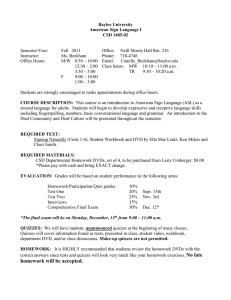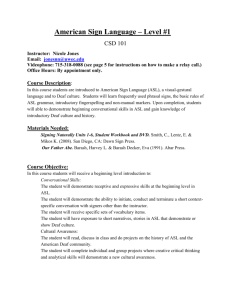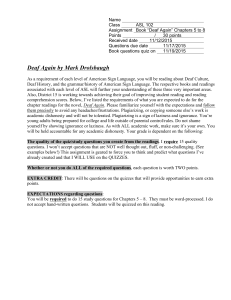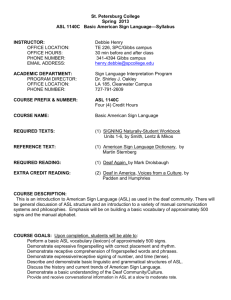AM 146 - AMERICAN SIGN LANGUAGE II
advertisement
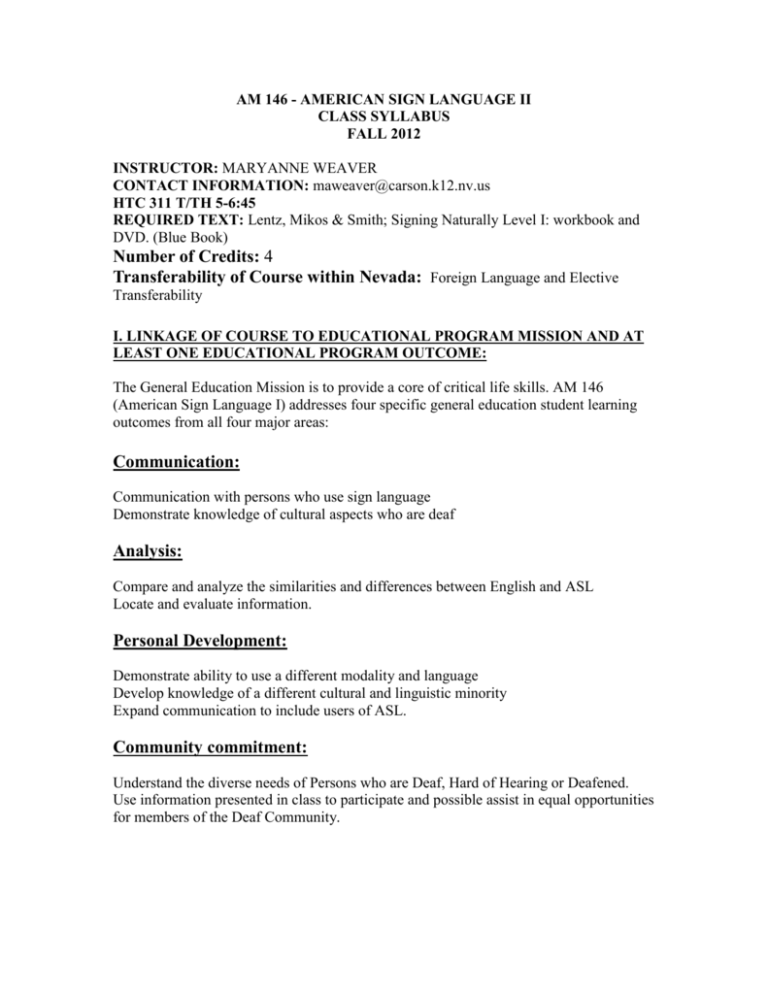
AM 146 - AMERICAN SIGN LANGUAGE II CLASS SYLLABUS FALL 2012 INSTRUCTOR: MARYANNE WEAVER CONTACT INFORMATION: maweaver@carson.k12.nv.us HTC 311 T/TH 5-6:45 REQUIRED TEXT: Lentz, Mikos & Smith; Signing Naturally Level I: workbook and DVD. (Blue Book) Number of Credits: 4 Transferability of Course within Nevada: Foreign Language and Elective Transferability I. LINKAGE OF COURSE TO EDUCATIONAL PROGRAM MISSION AND AT LEAST ONE EDUCATIONAL PROGRAM OUTCOME: The General Education Mission is to provide a core of critical life skills. AM 146 (American Sign Language I) addresses four specific general education student learning outcomes from all four major areas: Communication: Communication with persons who use sign language Demonstrate knowledge of cultural aspects who are deaf Analysis: Compare and analyze the similarities and differences between English and ASL Locate and evaluate information. Personal Development: Demonstrate ability to use a different modality and language Develop knowledge of a different cultural and linguistic minority Expand communication to include users of ASL. Community commitment: Understand the diverse needs of Persons who are Deaf, Hard of Hearing or Deafened. Use information presented in class to participate and possible assist in equal opportunities for members of the Deaf Community. II. Course Description: This course continues to stress the development of basic conversation skills with emphasis on expanding vocabulary and expressive skills. This ASL course satisfies the requirements for Foreign Language. III. Course Objectives: At the course conclusion of the course students will be able to sign the following: Giving Directions Describing people and things Making requests Talking about family and occupation Attributing qualities to others Discussing routines - Basic aspects of Deaf Culture with emphasis on educational practices, laws and challenges the Deaf Community Faces. Knowledge of agencies and services available for the Deaf. Understand the importance of cultural traditions, diversity and ethics in the modern world. Have effective and efficient learning skills, including the location and evaluation of information. GRADING: You will be graded on the following: 1. Attendance/Participation 2. Assignments/Quizzes/Workbook 3. Outside Reading 4. Mid-term Exam 5. Final Exam Total Percentage Possible 20% 20% 20% 20% 20% 100% A - 100%-90% , B - 89%-80%, C - 79%-70%, D - 69-60%, F - 59% - 0% and below = F The grade of an F will be given if the student does not officially withdraw from the class. ATTENDANCE/PARTICIPATION: To succeed in learning a visual and hands-on language attendance and participation plays a huge part. The more you involve yourself the more you will learn. If you miss a class it is your responsibility to get any handouts and information that you missed. If you are late for class please come in quietly find your seat and do not interrupt the class. Also if you are late it is your responsibility to get any missed information and to make sure you are marked present for that day. You are allowed one “free” absence and three excused absences. In order to have an absence excused you can attend a Deaf Event, Silent Dinner, Mentoring or Tutoring. If you attend a Deaf Event or Silent Dinner you are expected to write a short summery of the event. If you go to Mentoring or Tutoring you will have a form to keep track of your hours and turn this into me before the end of the semester. ASSIGNMENTS/WORKBOOK: Assignments (readings, quizzes, activities…) will be given periodically as a means for you to become more knowledgeable and comfortable with ASL. Upon the completion of each chapter your workbooks will be checked for a grade. If your workbook is late, you will receive half credit and it will only be accepted one session late. Upon the completion of 2 chapters in the workbook there will be a quiz. This is a total of 3 quizzes. All “breakaway” vocabulary will be included on the quizzes. This means any additional vocabulary that is handed out in class. BOOK REPORT: You are required to read at least one book on a Deaf related subject submitting a 3-5 page paper. This will be presented in class. Due dates for this project will be assigned at the beginning of the semester. STORY/LIFE EVENT: All students are required to sign a life event in front of the class. This project will be discussed in class. Dates for this will be assigned. MID-TERM EXAM: This will include all information covered in the book, class discussions, Deaf Culture, and hand outs given from the beginning of the semester till the mid-term testing date. It will be given in two parts. One part testing your receptive skills and the other part Deaf Culture related questions. FINAL EXAM: This exam will be COMPREHENSIVE, covering everything from the beginning of the semester till the day of the final. The exam will be given in two parts to examine your receptive and expressive skills. The expressive portion will be a conversation (provided by the teacher) between you and a partner. Dates for this will be given. Please make sure you are available on the scheduled date out of respect for your partner. Please note, there will be no make-up tests without prior arrangements between the instructor and the student. CELL PHONES: “Please” make sure your cell phones are not heard or seen. By this I mean that they are on “vibrate” or off and put away. If there is an emergency, let me know and we will make arrangements. Please there is also no texting while the class is in session. This proves to be distracting to classmates and you will also not be attentive to the activities of the class. PLAGIARISM/CHEATING POLICY: Plagiarism and/or cheating will earn you a O for that assignment/test and possible failure in the class…so just don’t do it! STATEMENT OF ACADEMIC INTEGRITY: I expect all students to conduct themselves ethically. Do unto others as you would like to be done to you. COURSE COMMENT: Linguistic research demonstrates that ASL is comparable in complexity and expressiveness to all other spoken language. AMERICN SIGN LANGUAGE “ IS NOT” A FORM OF ENGLISH, however ASL does in fact have its own distinct grammar structure and differs from that of spoken language in that it is a VISUAL, 3-D language. **I encourage any student needing to request accommodations for a specific disability to please meet with me privately to ensure your success. You will also need to contact Susan Trist, the DSS coordinator (445-3275 or Bristlecone building, Room 103) at your earliest convenience to ensure timely and appropriate accommodations. Instructor has the right to adjust the syllabus as needed. WELCOME, AND LETS HAVE FUN LEARNING THE MOST BEAUTIFUL LANGUAGE IN THE WORLD !!!! STUDENT AGREEMENT WITH INSTRUCTOR Course Name______________________________ Semester_______________________ I affirm that I have read and understand the entire course syllabus. I am aware that this syllabus explains how my grade in the course will be determined and provides an explanation of my instructor’s expectations. In addition, I understand that as a student at this institution, I am expected to follow guidelines for academic integrity and civility as established in the documents and policies of this institution (see Academic and Student Affairs policy 3-4-5 on Academic Integrity in addition to Principals of Community as established by the president’s office). I am also expected to heed reasonable community standards in any communication or contact with fellow students and my instructor (even if not explicitly set forth in the course syllabus or this institution’s code). Signed: ___________________________________Date:________________________ Print Name: _______________________________ PLEASE SIGN AND RETURN TO INSTRUCTOR BY August 20, 2012


